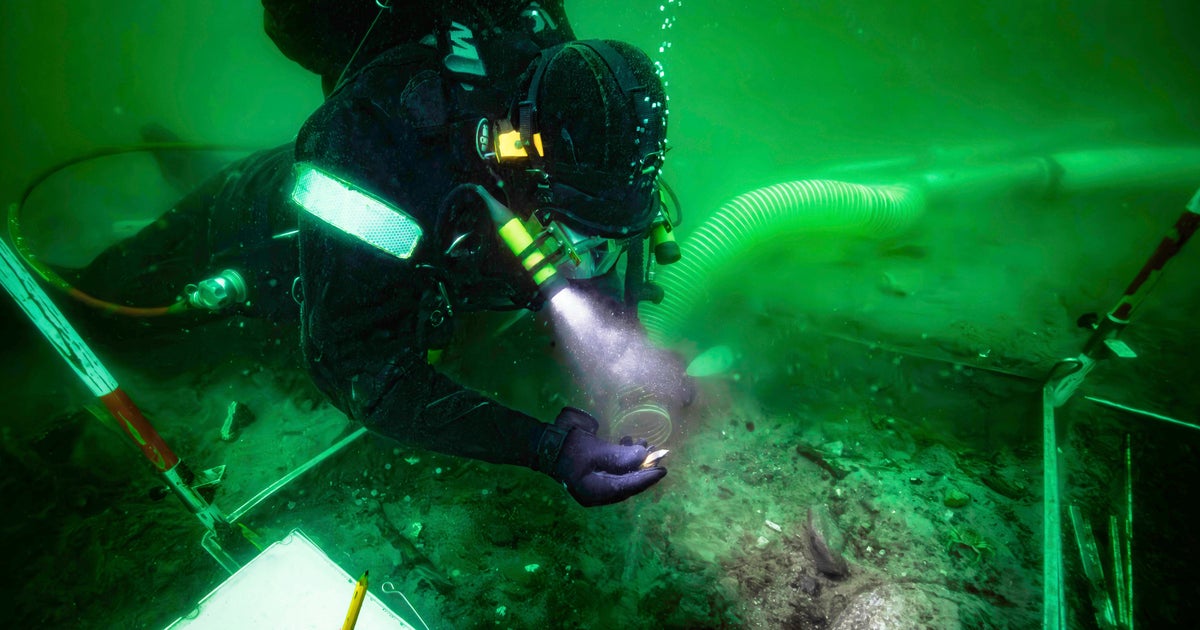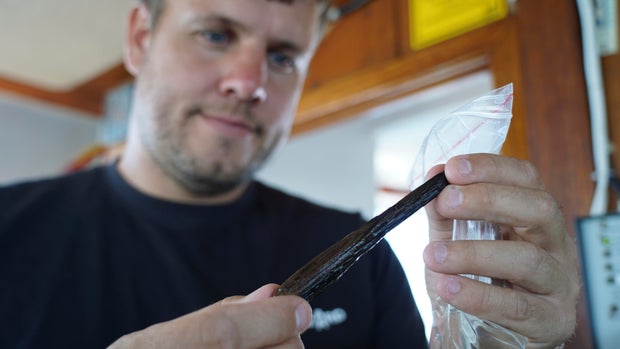Bay of Aarhus, Denmark — Below the dark blue waters of the Bay of Aarhus in northern Denmark, archaeologists search for coastal settlements swallowed by rising sea levels more than 8,500 years ago.
This summer, divers descended about 26 feet below the waves close to Aarhus, Denmark’s second-biggest city, and collected evidence of a Stone Age settlement from the seabed.
It’s part of a $15.5 million six-year international project to map parts of the seabed in the Baltic and North Seas, funded by the European Union, that includes researchers in Aarhus as well as from the U.K.’s University of Bradford and the Lower Saxony Institute for Historical Coastal Research in Germany.
The goal is to explore sunken Northern European landscapes and uncover lost Mesolithic settlements as offshore wind farms and other sea infrastructure expand.
Søren Christian Bech/AP
Most evidence of such settlements so far has been found at locations inland from the Stone Age coast, said underwater archaeologist Peter Moe Astrup, who’s leading underwater excavations in Denmark.
“Here, we actually have an old coastline. We have a settlement that was positioned directly at the coastline,” he said. “What we actually try to find out here is how was life at a coastal settlement.”
After the last ice age, huge ice sheets melted and global sea levels rose, submerging Stone Age settlements and forcing the hunter-gatherer human population inland.
About 8,500 years ago, sea levels rose by about 6.5 feet per century, Moe Astrup said.
Moe Astrup and colleagues at the Moesgaard Museum in Højbjerg, just outside Aarhus, have excavated an area of about 430 square feet at the small settlement they discovered just off today’s coast.
Early dives uncovered animal bones, stones tools, arrowheads, a seal tooth, and a small piece of worked wood, likely a simple tool. The researchers are combing the site meter by meter using a kind of underwater vacuum cleaner to collect material for future analysis.
James Brooks/AP
They hope further excavations will find harpoons, fishhooks or traces of fishing structures.
“It’s like a time capsule,” Moe Astrup said. “When sea level rose, everything was preserved in an oxygen-free environment … time just stops.”
“We find completely well-preserved wood,” he added. “We find hazelnut. … Everything is well preserved.”
Excavations in the relatively calm and shallow Bay of Aarhus and dives off the coast of Germany will be followed by later work at two locations in the more inhospitable North Sea.
The sea level rise thousands of years ago submerged, among other things, a vast area known as Doggerland that connected Britain with continental Europe and now lies underneath the southern North Sea.
To build a picture of the rapid rise of the waters, Danish researchers are using dendrochronology, the study of tree rings.
Submerged tree stumps preserved in mud and sediment can be dated precisely, revealing when rising tides drowned coastal forests.
“We can say very precisely when these trees died at the coastlines,” Moesgaard Museum dendrochronologist Jonas Ogdal Jensen said as he peered at a section of Stone Age tree trunk through a microscope.
“That tells us something about how the sea level changed through time.”
As today’s world faces rising sea levels driven by climate change, the researchers hope to shed light on how Stone Age societies adapted to shifting coastlines more than eight millennia ago.
“It’s hard to answer exactly what it meant to people,” Moe Astrup said. “But it clearly had a huge impact in the long run because it completely changed the landscape.”
Sea levels rose by a global average of around 1.7 inches in the decade up to 2023.
Denmark has seen several significant archaeological discoveries in recent years, including a metal detectorist’s stunning find early last year of gold ring set with a red semi-precious stone that researchers hoped would shed light on the country’s history during the early middle ages.
Officials at the National Museum of Denmark announced that find after the centuries-old ring, believed to have been owned by a member of the royal family some 1,400 years ago, was transferred from a different museum nearer to the discovery site in the south, near the German border.
That discovery came just weeks after archaeologists found a small knife inscribed with runic letters dated to the first or second century AD, or almost 2,000 years ago. It was the oldest trace of writing ever found in Denmark, according to the Museum Odense.
Runes, or runic letters, are the oldest alphabet known to have been used in Scandinavia, having been in use for about 1,000 years until they were largely replaced by the Latin alphabet when Christians started spreading their belief system in the 10th century.
Earlier this year, officials announced that a piece of fossilized vomit, dating back to when dinosaurs roamed the earth, was discovered in Denmark.


